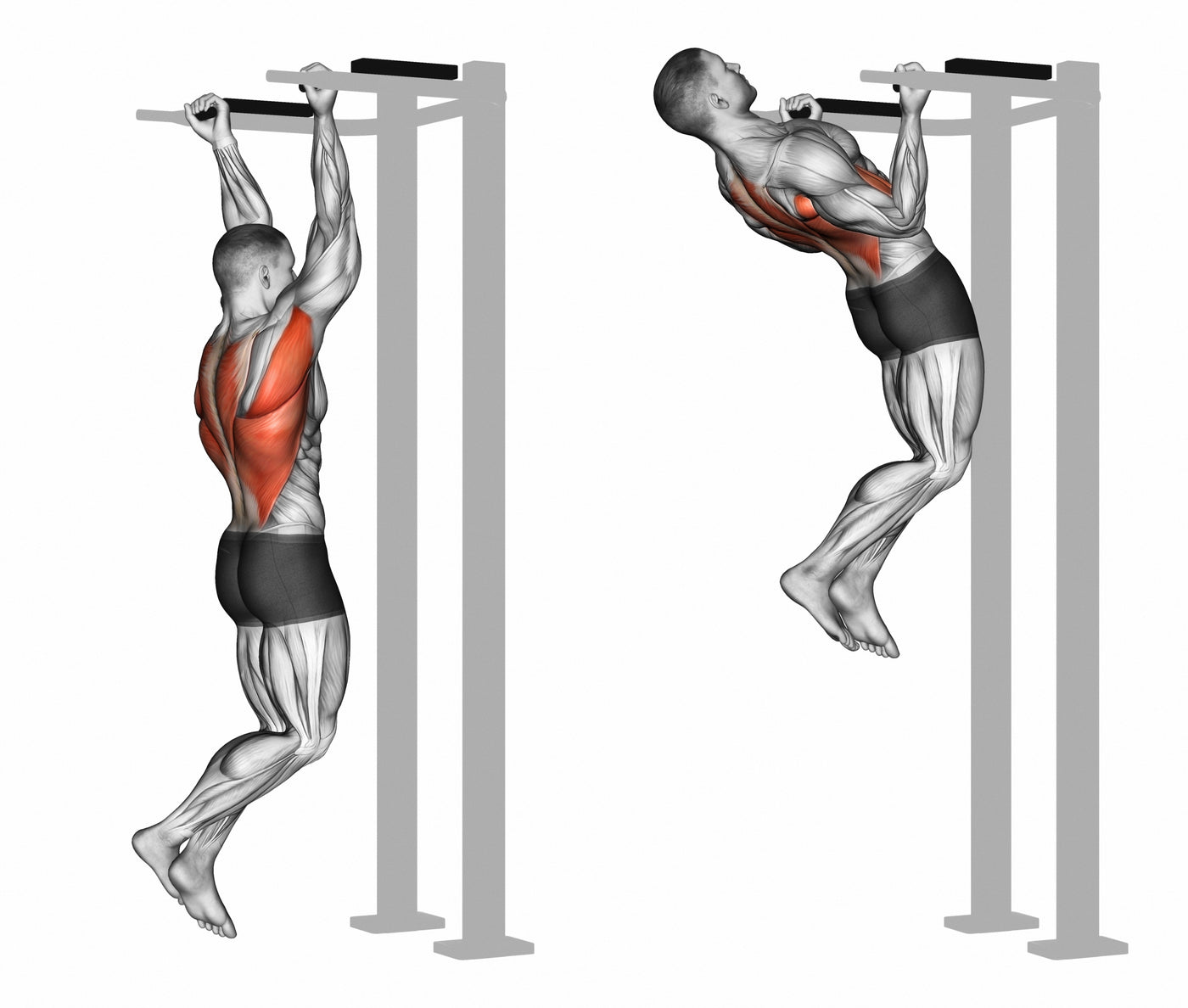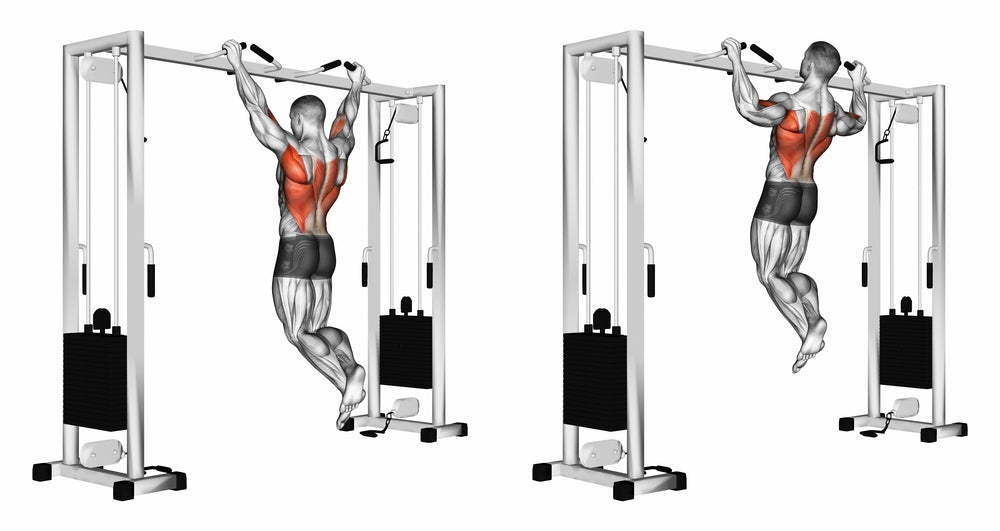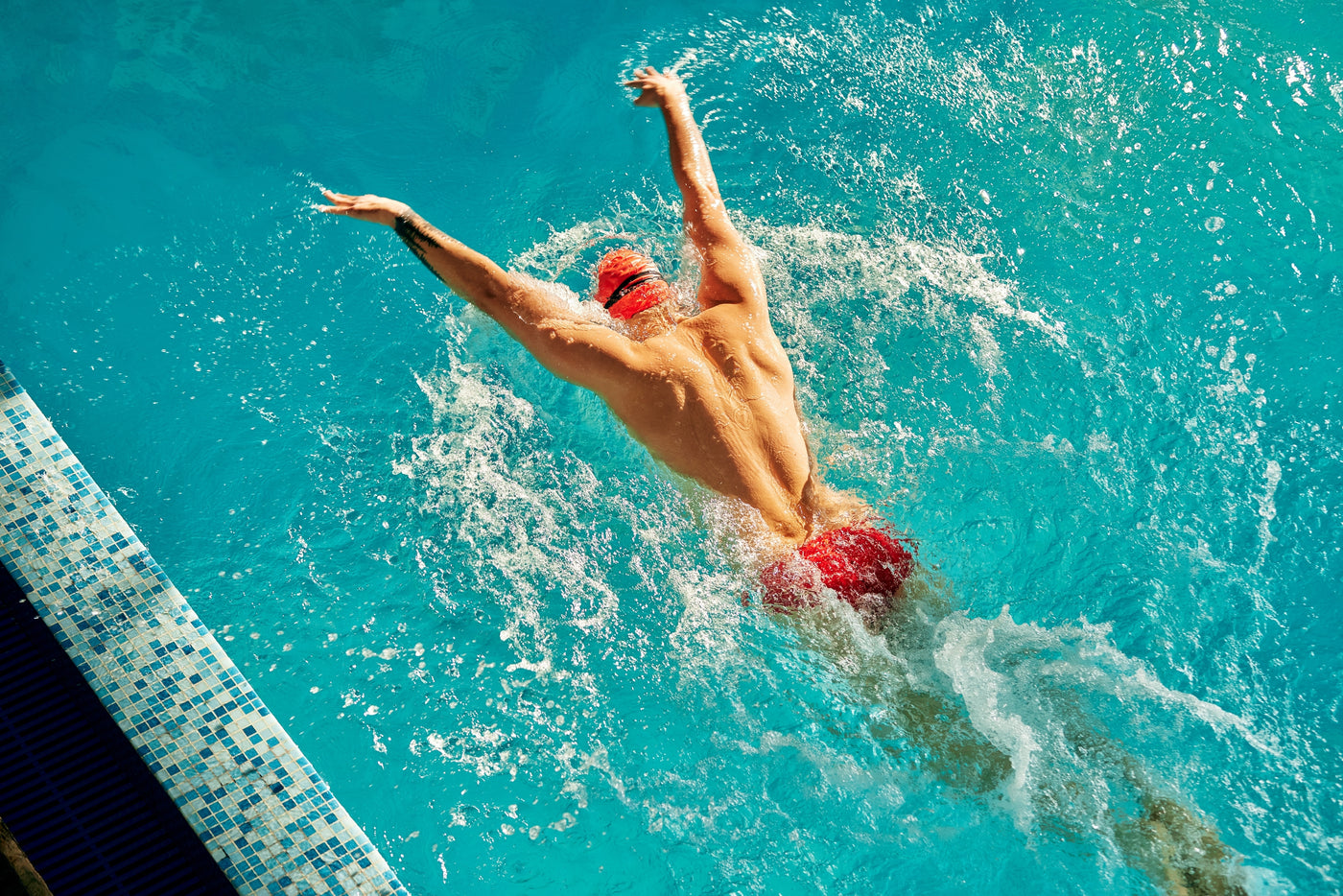Kinesiology of Exercise
Chinup/Pullup
With the increasing popularity of lat pull-down machines, pull-ups and chin-ups have lost some of their appeal mainly because they are too difficult for many people. However, these are excellent exercises that can be used to strengthen specific muscles or portions of them. In addition, they can help you learn to control and move your entire body. Because of this, they should be in your repertoire of exercises, especially if you are an athlete.

Major Muscles and Actions Involved
Supinated or neutral grip (chin-up)
The muscles and actions are the same as in the narrow grip lat pull-down, but with different stress on the muscles. However, in this exercise the body moves toward the arms rather than vice versa as in the lat pull-down.

MAJOR MUSCLES AND ACTIONS INVOLVED
Pronated grip (pull-up)
In this exercise the muscles and actions are the same as for the wide pronated grip lat pull-down, but with different stress on the muscles. However, in this exercise, as in variant 1, the body moves toward the arms rather than the arms toward the body as in the lat pull-down. Note that both of these grips and other grips are possible when using the Adjustable Pull-up apparatus. It allows for a change in width of grip, the use of a pronated, supinated, 45 degree level and angled pronated grips.

Sports Uses
Chin-ups and pull-ups include movements that are very important in gymnastics, especially in the pulling-up movements on the horizontal bar, rings, and parallel bars. These exercises also help develop the muscles used in all forms of rowing, football tackling (grabbing and pulling in), all swimming strokes, but mainly the adductor action, all climbing movements, especially rope and mountain climbing and bodybuilding. Pull-ups are also very important for good posture because they help keep the shoulders back and produce breadth in the upper back. For bodybuilders this exercise is very important for development of the muscles to create a wide back.
Exercise Analysis
- For proper execution, it is best to have a bar high enough so that a small jump will be sufficient to enable you to grasp the bar and allow your body to hang freely. If the bar is too low, it will be necessary to bend your lower legs under your body so that you have no contact with the floor.
- When you are using a supinated grip, the biceps brachii muscle has a more favorable straight line of pull, which makes the exercise easier to perform. With a pronated grip, the biceps tendon "wraps around" the radius, and when the muscle contracts, it tends to pull "around a corner". Because of this, the load falls on the brachialis and the shoulder muscles. This is why the pronated grip is more difficult to execute.
Chinups vs Pullups
Chin-ups and pull-ups are both upper-body exercises that target the muscles in the back, shoulders, and arms, but they differ in the grip and muscle emphasis.
Chin-ups:
- Grip: Palms facing towards you (underhand grip).
- Target Muscles: Primarily works the biceps, along with the back and shoulders.
- Movement: Pulling your body upward until your chin is above the bar.
- Difficulty: Generally considered slightly easier for beginners due to the involvement of the biceps.
Pull-ups:
- Grip: Palms facing away from you (overhand grip).
- Target Muscles: Emphasizes the muscles in the upper back, lats, and shoulders.
- Movement: Lifting your body until your chin passes the level of the bar.
- Difficulty: Often considered more challenging as it relies more on the back muscles.
In summary, the primary distinction lies in the grip and the muscles emphasized. Chin-ups focus more on the biceps, while pull-ups target the upper back and lats. Both exercises are excellent for building upper-body strength and can be incorporated into a well-rounded fitness routine.
Pullups vs Lat Pulldown
Pull-ups and lat pulldowns are both exercises that target the muscles of the upper back and can be valuable additions to a strength training routine, but they differ in terms of equipment, execution, and some aspects of muscle engagement.
Pull-ups:
- Equipment: Typically performed on a pull-up bar.
- Body Movement: Involves lifting your body weight using your arms, primarily targeting the upper back, lats, and biceps.
- Difficulty: Can be challenging, especially for beginners, as it requires lifting your entire body weight.
- Functional Aspect: Mimics natural pulling movements and engages stabilizing muscles.
Lat Pulldown:
- Equipment: Uses a cable machine with a pulldown bar or attachment.
- Body Movement: Involves pulling the bar down towards the chest while sitting or kneeling. The weight is often adjustable.
- Target Muscles: Primarily focuses on the latissimus dorsi (lats) and also engages the muscles in the upper back and biceps.
- Difficulty: Easier to adjust the resistance, making it more suitable for individuals at different fitness levels.
In summary, pull-ups are a bodyweight exercise performed on a bar, emphasizing natural pulling movements and engaging various muscles. Lat pulldowns, on the other hand, use a cable machine to target similar muscle groups but provide the advantage of adjustable resistance, making them more accessible for individuals with different strength levels. Both exercises can contribute to overall upper back development, and their inclusion in a workout routine can be based on individual preferences and fitness goals.

Want to Learn More?
Try our premium ebooks on the kinesiology of exercise. Satisfaction guaranteed.
